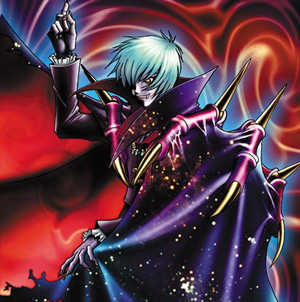It’s named Vampire Format after Vampire Lord (but that card isn’t used a ton because players can counter it with 3 DD Warrior Ladies).
This is the format right before Invasion of Chaos (BLS and Chaos Emperor).
2 defining features of this format:
1) Lots of power spells. Cards like Forceful Sentry, Confiscation, Harpie’s Feather Duster, etc. weren’t banned yet. There are a lot of good cards in this format, which makes deck space tight.
2) Tons of monster removal, spell/trap removal and hand removal cards. Yet few cards that generate big card advantage. As a result, in the late-game, game-states become reduced. Players have less cards later on. This means “how good is a card when topdecked” is valuable.
Metamorphosis and Scapegoat are allowed in this format, but there’s not much room for spells. And the ruling where you can flip monsters immediately after using Tsukuyomi on them wasn’t made yet.
This is still a work in progress, but here’s a sample deck.
https://www.duelingbook.com/deck?id=8626910
Of the monsters, the hard-staples are, in my opinion: Sangan, Witch, 1+ Magician of Faith, Sinister, Breaker, and arguably Tribe and 1-2+ DD Warrior Lady.
If you want, you can make this into even more of a Warrior deck (2nd Reinforcement of the Army, 1 Don Zaloog, maybe a Zombyra, a Sasuke Soldier in the side deck).
Sinister Serpent is great. Enables Graceful and Painful. Survives Duo. Can bluff Change of Heart, Raigeki and Dark Hole. Keeps you alive late-game in reduced states.
Yata-Garasu. It’s a win condition, insanely strong late-game in a reduced game-state. But it’s also a win-more card: you need to already have an advantage to benefit from it, so it may not be totally mandatory.
Fiber Jar. With this card, you can play for life advantage and then reset the game to stop the opponent’s life point advantage.
Gravekeeper’s Spy isn’t in this list, but it can be very good. It can +1. Force out the opponent’s removal cards. It counters DD Warrior Lady and 1900 beaters.
Airknight Parshath vs. Jinzo. Jinzo gets over 1900 beaters. However, Airknight still gets over most monsters in this format (barring Spy and 1900 ATK’s) and it plusses. With 3 MST, you can setup Airknight’s attack and stop Snatch Steal. Jinzo’s trap negation is somewhat overkill in this format; players use very few traps and there’s lots of trap removal anyway (MST’s, Heavy, HFD, Breaker).
How many Tribute monsters to use? 0-2.
The upside of having 2 tributes is that if 1 gets hit with DDWL, you can still have another to revive with Premature/Call. Also, you can take advantage of Change of Heart/Snatch Steal. Or use revival cards on Witch/Sangan, then Tribute them.
The downsides: Too many tributes clogs up your hand early game if you can’t dump them with Graceful or Painful yet. And getting good tribute fodder is hard; you don’t want to tribute beaters like DDWL/Skilled Dark. But you rarely get Witch/Sangan/MOF surviving more than a turn to sacrifice them. And top-decking Tributes late-game sucks. So, I’m at 1 tribute for now (this may change).
For your 1900 LV4 beater. You can use Skilled Dark Magician (1700 DEF survives Breaker and Tribe) or Archfiend Soldier (1500 DEF but searchable by Witch). Slate Warrior potentially gets up to 2400, but with few trap cards in this format and ample removal, it likely won’t survive a turn set.
Mirage of Nightmare: big card advantage. MST is kept at 3 to enable it.
Hot Take: Heavy Storm isn’t always a staple and could be side decked. There’s already plenty of spell/trap removal, and few trap cards in this format. With all the spell/trap removal in this format, opponents aren’t going to set their spells as bluffs (especially their powerful ones). I actually like MST better than heavy because of the synergy with Mirage, and it can be chained to Premature/Book.
Side Deck:
- The Warrior engine as mentioned above could be good.
- Extra removal cards like 1-2 Noblemans and 1-2 Torrentials.
- Whatever “staples” you decide you don’t have room for in the main
- Cards to consider against rogue decks. Poison of the Old Man (healing effect against Scientist OTK). Royal Decree against Ojama/Secret barrel burn. Maybe Waboku against aggro?
